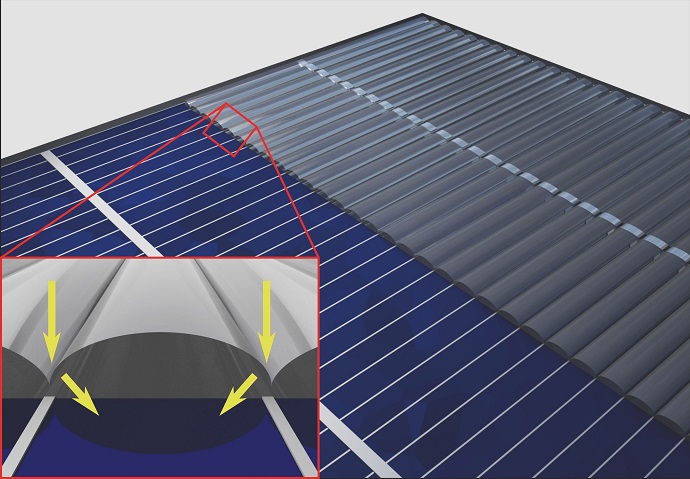September 25, 2015
Success of the energy turnaround will depend decisively on the extended use of renewable energy sources. However, their efficiency partly is much smaller than that of conventional energy sources. The efficiency of commercially available photovoltaic cells, for instance, is about 20%. Scientists of Karlsruhe Institute of Technology (KIT) have now published an unconventional approach to increasing the efficiency of the panels. Optical invisibility cloaks guide sunlight around objects that cast a shadow on the solar panel, such as contacts for current extraction. DOI: 10.1364/OPTICA.2.000850.
Energy efficiency of solar panels has to be improved significantly not only for the energy turnaround, but also for enhancing economic efficiency. Modules that are presently mounted on roofs convert just one fifth of the light into electricity, which means that about 80% of the solar energy are lost. The reasons of these high losses are manifold. Up to one tenth of the surface area of solar cells, for instance, is covered by so-called contact fingers that extract the current generated. At the locations of these contact fingers, light cannot reach the active area of the solar cell and efficiency of the cell decreases.
“Our model experiments have shown that the cloak layer makes the contact fingers nearly completely invisible,” doctoral student Martin Schumann of the KIT Institute of Applied Physics says, who conducted the experiments and simulations. Physicists of KIT around project head Carsten Rockstuhl, together with partners from Aachen, Freiburg, Halle, Jena, and Jülich, modified the optical invisibility cloak designed at KIT for guiding the incident light around the contact fingers of the solar cell.
Normally, invisibility cloak research is aimed at making objects invisible. For this purpose, light is guided around the object to be hidden. This research project did not focus on hiding the contact fingers visually, but on the deflected light that reaches the active surface area of the solar cell thanks to the invisibility cloak and, hence, can be used.
To achieve the cloaking effect, the scientists pursued two approaches. Both are based on applying a polymer coating onto the solar cell. This coating has to possess exactly calculated optical properties, i.e. an index of refraction that depends on the location or a special surface shape. The second concept is particularly promising, as it can potentially be integrated into mass production of solar cells at low costs. The surface of the cloak layer is grooved along the contact fingers. In this way, incident light is refracted away from the contact fingers and finally reaches the active surface area of the solar cell (see Figure).
By means of a model experiment and detailed simulations, the researchers demonstrated that both concepts are suited for hiding the contact fingers. In the next step, it is planned to apply the cloaking layer onto a solar cell in order to determine the efficiency increase. The physicists are optimistic that efficiency will be improved by the cloak under real conditions: “When applying such a coating onto a real solar cell, optical losses via the contact fingers are supposed to be reduced and efficiency is assumed to be increased by up to 10%,” Martin Schumann says.
Publication:
Martin F. Schumann, Samuel Wiesendanger, Jan Christoph Goldschmidt, Benedikt Bläsi, Karsten Bittkau, Ulrich W. Paetzold, Alexander Sprafke, Ralf B. Wehrspohn, Carsten Rockstuhl, and Martin Wegener, "Cloaked contact grids on solar cells by coordinate transformations: designs and prototypes," Optica 2, 850-853 (2015)
DOI: 10.1364/OPTICA.2.000850
More information on invisibility cloak research at KIT:
www.kit.edu/kit/pi_2014_15233.php and
www.kit.edu/kit/pi_2011_6866.php















